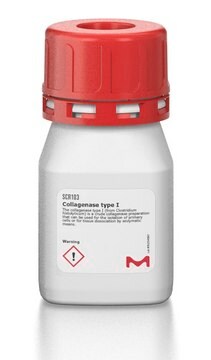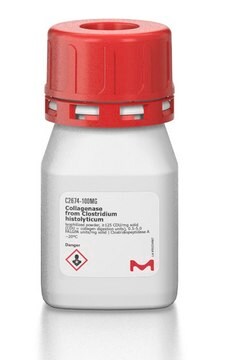C1639
Collagénase from Clostridium histolyticum
0.2 μm filtered, for general use, Type I-S, 0.2-1.0 FALGPA units/mg solid, ≥125 CDU/mg solid
Synonyme(s) :
Clostridiopeptidase A
About This Item
Produits recommandés
Niveau de qualité
Stérilité
0.2 μm filtered
Forme
lyophilized powder
Activité spécifique
≥125 CDU/mg solid
0.2-1.0 FALGPA units/mg solid
Poids mol.
68-130 kDa
Température de stockage
−20°C
Vous recherchez des produits similaires ? Visite Guide de comparaison des produits
Catégories apparentées
Application
Actions biochimiques/physiologiques
Attention
Définition de l'unité
Notes préparatoires
Substrat
Mention d'avertissement
Danger
Mentions de danger
Conseils de prudence
Classification des risques
Eye Irrit. 2 - Resp. Sens. 1 - Skin Irrit. 2 - STOT SE 3
Organes cibles
Respiratory system
Code de la classe de stockage
11 - Combustible Solids
Classe de danger pour l'eau (WGK)
WGK 1
Point d'éclair (°F)
Not applicable
Point d'éclair (°C)
Not applicable
Équipement de protection individuelle
dust mask type N95 (US), Eyeshields, Faceshields, Gloves
Faites votre choix parmi les versions les plus récentes :
Déjà en possession de ce produit ?
Retrouvez la documentation relative aux produits que vous avez récemment achetés dans la Bibliothèque de documents.
Les clients ont également consulté
Protocoles
This procedure may be used for Collagenase products.
Notre équipe de scientifiques dispose d'une expérience dans tous les secteurs de la recherche, notamment en sciences de la vie, science des matériaux, synthèse chimique, chromatographie, analyse et dans de nombreux autres domaines..
Contacter notre Service technique






